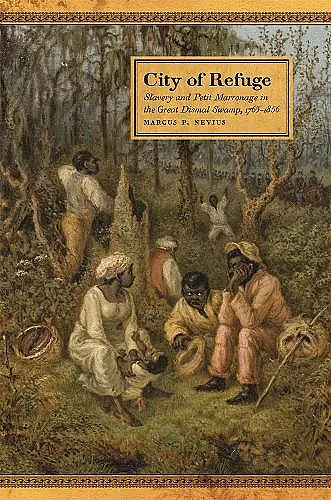City of Refuge
Slavery and Petit Marronage in the Great Dismal Swamp, 1763–1856
Format:Hardback
Publisher:University of Georgia Press
Published:1st Feb '20
Should be back in stock very soon

Race, trade, and community in a legendarily difficult southern terrain
Often with the tacit acceptance of white company agents, company slaves engaged in various exchanges of goods and provisions with maroons—networks that padded company accounts even as they helped to sustain maroon colonies and communities.
In his examination of life, commerce, and social activity in the Great Dismal Swamp, Marcus P.
City of Refuge is a story of petit marronage, an informal slave’s economy, and the construction of internal improvements in the Great Dismal Swamp of Virginia and North Carolina. The vast wetland was tough terrain that most white Virginians and North Carolinians considered uninhabitable. Perceived desolation notwithstanding, black slaves fled into the swamp’s remote sectors and engaged in petit marronage, a type of escape and fugitivity prevalent throughout the Atlantic world. An alternative to the dangers of flight by way of the Underground Railroad, maroon communities often neighbored slave-labor camps, the latter located on the swamp’s periphery and operated by the Dismal Swamp Land Company and other companies that employed slave labor to facilitate the extraction of the Dismal’s natural resources. Often with the tacit acceptance of white company agents, company slaves engaged in various exchanges of goods and provisions with maroons—networks that padded company accounts even as they helped to sustain maroon colonies and communities.
In his examination of life, commerce, and social activity in the Great Dismal Swamp, Marcus P. Nevius engages the historiographies of slave resistance and abolitionism in the early American republic. City of Refuge uses a wide variety of primary sources—including runaway advertisements; planters’ and merchants’ records, inventories, letterbooks, and correspondence; abolitionist pamphlets and broadsides; county free black registries; and the records and inventories of private companies—to examine how American maroons, enslaved canal laborers, white company agents, and commission merchants shaped, and were shaped by, race and slavery in an important region in the history of the late Atlantic world.
In addition to a careful social history of this untamable land, Nevius has written a thoughtful reflection on the various ‘landscapes of slavery’ that spread over early America. He directly engages with the perennial problem of archival silence, reading all kinds of documents—tax records, work contracts, company orders—against the grain. In this way he enables at least some of the people who endured “swamp slavery” to tell us how they survived.
-- J. M. Opal * Journal of Southern HistoISBN: 9780820356426
Dimensions: unknown
Weight: unknown
168 pages